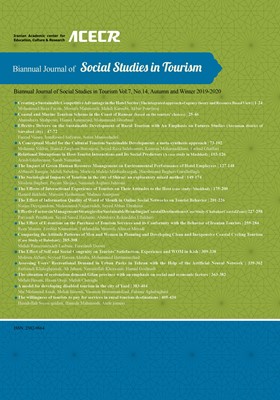The situation of ecotourism demand Gilan province with an emphasis on social and economic factors
Subject Areas :mehdi hesam 1 , hasan oroji 2 , mahdi cheraghi 3
1 - guilan
2 - University of Yazd
3 - University of Tehran
Keywords: demand, motivation, tourism, ecotourism, Gilan province,
Abstract :
Ecotourism has attracted much attention in recent years. A critical issue in ecotourism is to understand the state of demands. Demand is typically measured in terms of the tourism market. The tourism market is linked to the region of tourism products, and the characteristics and preferences of their representatives. Noting ecotourism, this study analyzed the demand situation of ecotourism in Gilan province. The statistical population of all tourists entering Gilan province was 384 individuals. Wilcoxon, Binomial, and T-test were used to analyze the data. The results showed that the role of geo-touristic attractions such as coasts and forest areas was essential for the present and future travel of tourists to Gilan. However, the goal of many tourists to these attractions was mere fun. Thus, they suggested little ecotourism motives. The services of the indigenous people and lodging in indigenous resorts did not have high effects on the travel of tourists and did not create much incentive for them.
اروجی، حسن. (1396). «تبیین روند توسعه گردشگری در مناطق روستایی (مورد مطالعه: شهرستان خور و بیابانک)». رساله دکتری جغرافیا و برنامه ریزی روستایی. به راهنمایی دکتر جلالیان و رضوانی. دانشگاه خوارزمی تهران.
توطنی، سارا و فرحی¬نیا، امیرحسین. (1391). «معماری بوم¬گردی: بازشناسی نقش معماری پایدار در توسعه گردشگری زیست محیطی». اولین همایش ملی اندیشه¬ها و فناوری¬های نو در معماری.
حاتمی نژاد، حسین؛ اروجی، حسن؛ شکروی، نگین؛ مولایی قلیچی، محمد (1393)؛ بررسی و ارزیابی سایتهای گردشگری شهری (مطالعه موردی: شهر ارومیه)؛ مجله برنامه ریزی و توسعه گردشگری، سال سوم، شماره 9، صص 152-169.
رنجبریان، بهرام و قنبری، حسن. (1386). «وجهه استنباط شده از مقصد گردشگری عاملی برای کسب مزیت رقابتی در صنعت توریسم و گردشگری». مجله پژوهشی دانشگاه اصفهان. شماره 27، صص 1-13.
ره، نادیا. (1394). «بررسی معماری مناطق کوهستانی گیلان؛ ارائه راهکارها و چالش ها به منظور توسعه گردشگری». همایش ملی عمران و پایداری با رویکردی بر توسعه پایدار.
سازمان نقشه برداری ایران (1393)، لایه تقسمیات کشوری ایران.
سقایی، مهدی؛ خواجه شکوهی، علیرضا و جوانبخت قهفرخی، زهره. (1391). «پهنه¬بندی مناطق مستعد ایجاد خدمات اقامتی در کلانشهر مشهد (با استفاده از مدل AHP)». مجله پژوهش و برنامه¬ریزی شهری. سال سوم، شماره یازدهم، صص 73-96.
فرجی، الدوز؛ جوانمردی، کیامرز؛ میرباذل، سید جلال. (1392). «طراحی مجتمعهای اقامتی، تفریحی و گردشگری با رویکرد معماری بومی در گیلان». کنفرانس بین المللی عمران، معماری و توسعه پایدار شهری.
Burger C., & Dohnal M., & Kathrada M. & Law R. (2001), A practitioners guide to time-series methods for tourism demand forecasting a case study of Durban,South Africa; Tourism Management, 22 (2001), 403-409.
Beeton, S. (2006). community development thorough tourism; published by land links
Christian C. (2018), The Caribbean’s Geotourism Potential and Challenges: A Focus on Two Islands in the Region, geoscience, Vol 8, pp 273.
Cohen E. (1988), Traditions on the qualitative sociology of tourism. Annals of Tourism Research 15, 29–46. Goh, G. (2012), Exploring impact of climate on tourism demand; Annals of Tourism Research, Vol. 39, No. 4, pp. 1859–1883, 2012.
Garin-munoz T., & Montero-Martin L. (2007); Tourism in the Balearic Islands: A dynamic model for international demand using panel data; Tourism Management, V 28, pp. 1224–1235
Hadzic, O & Markovi, S & Vasiljevic, D & Nedeljkovic, M. (2010), A dynamical model for assessing tourism market atractivitness of a geosite; GEOTRENDS, pp 23-25.
Homans, C. G. (1958). Social Behavior as Exchange. American Journal of Sociology 63: 597-606. Jampol G., & Mehta H. (2004), ecolodges; International Finance Corporation.
Lim C., & Chan F. (2011), an econometric analysis of hotel–motel room nights in New Zealand with stochastic seasonality, International Journal of Revenue Management, No 5, Vol 1.
Lindberg K., & Hawkins D. (1993), Ecotourism: A Guide for Planners and Managers, Volume 1; ecotourism society.
Martin C., & Witt S. (1988), Substitute prices in models of tourism demand; Annals of tourism Research, Vol. 15, pp. 255-268, 1988.
Morley C. (1992), A MICROECONOMIC THEORY OF INTERNATIONAL TOURISM DEMAND; Annul of Tourism Research, Vol. 19. pp. 250-267, 1992.
Sai-leung, N. G & Jiangfeng, L. I & Shiming, F & Young C.Y. NG. (2010); geodiversity and geoconservation in hong kong; Asian Geographer 27 (1 -2), pp 1-11.
Serra, G. (2007), Ecotourism in the PALMYRA Desert, SYRIA A Feasibility Study.
Sun, soo pyo, Uysal Muzaffer, Mc lallen robert; (1991); A linear expenditure model for tourism demand. Annals of Tourism Research, Vol. 18, pp. 443-454.
Sofia E., & Rowshan A.B., & Mohd Shafia L. (2016), competitive advantage of geotourism market in Malaysia: a comparison among ASEAN economics, 3rd global conference on business and social science -2015, Kuala lampour, Malaysia.
Soledad O., & Alvarez-Diaz M., & Gonzalez-Gomez M. (2012); Estimating the long-run effects of socioeconomic and meteorological factors on the domestic tourism demand for Galicia (Spain); Tourism Management 33 (2012) 1301e1308.
Sunday, A. (1978), Foreign travel and tourism prices and demand; Annals of tourism research, April/June 1978.
Yang Y., & Ze-Hua L., & Qiuyin Q. (2014), Domestic tourism demand of urban and rural residents in China: Does relative income matter?; Tourism Management, Vol 40. Pp.193-202.
Yap G, Allen D. (2011), investigating other leading indicators influencing Australian domestic tourism demand; Mathematics and Computers in Simulation, 81 (2011) 1365–1374.
Zhou, L., & Chan, E., & Song, H. (2017), Social capital and entrepreneurial mobility in early -stage tourism development: A case from rural China. Tourism management, Vole 63, pp. 338-350.


